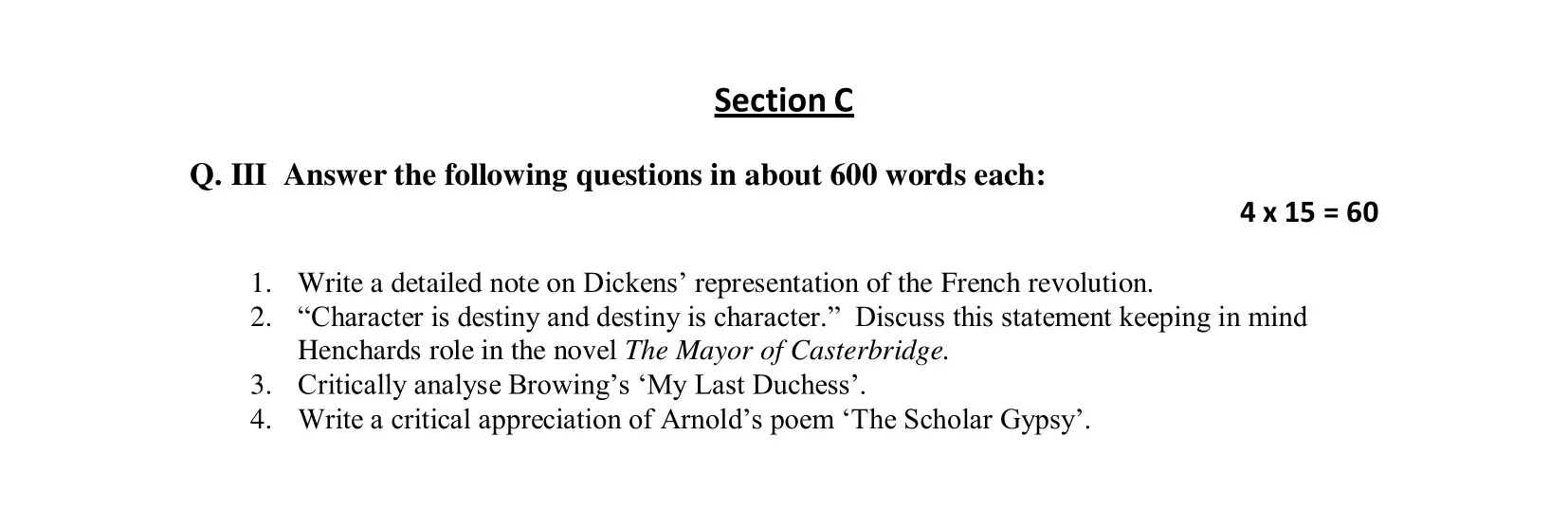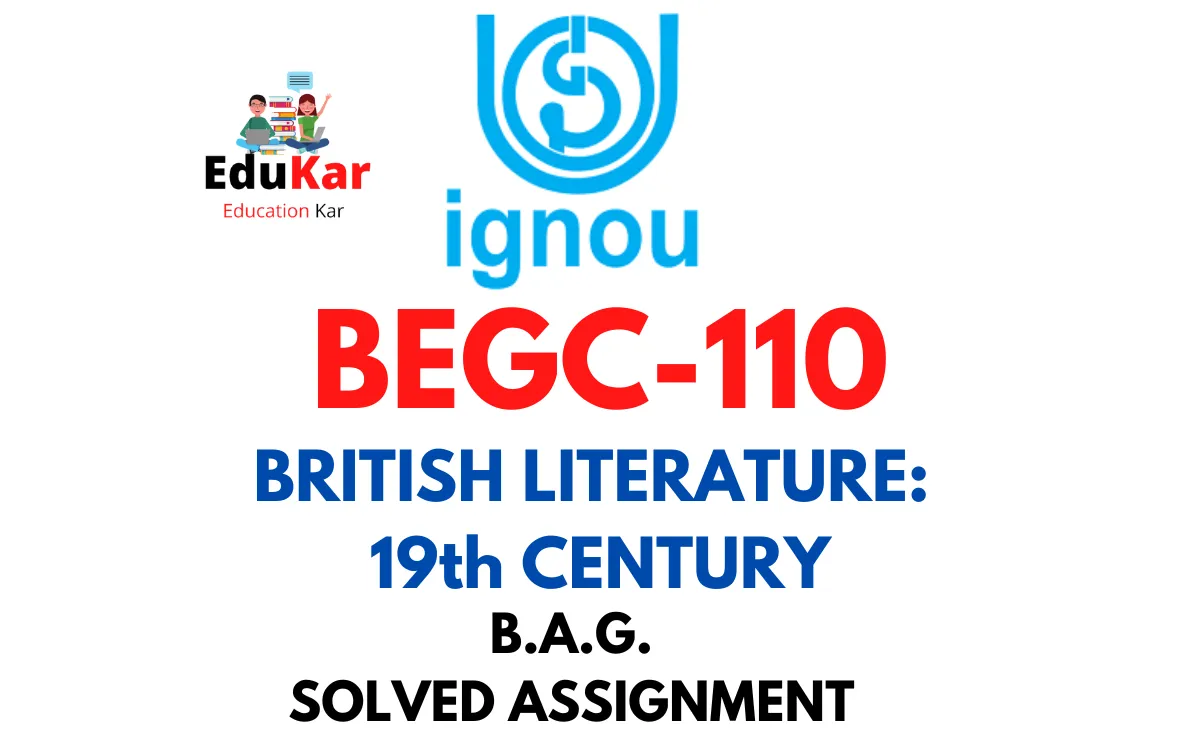
| Title | BEGC-110: IGNOU BAG Solved Assignment 2022-2023 |
| University | IGNOU |
| Degree | Bachelor Degree Programme |
| Course Code | BEGC-110 |
| Course Name | BRITISH LITERATURE: 19th CENTURY |
| Programme Name | Bachelor of Arts (General) |
| Programme Code | BAG |
| Total Marks | 100 |
| Year | 2022-2023 |
| Language | English |
| Last Date for Submission of Assignment: | For June Examination: 31st April For December Examination: 30th September |


Section A
Q.I Explain with reference to context the following lines:
(i) Let us swear an oath, and keep it with an equal mind,
In the hollow Lotos-land to live and lie reclined
On the hills like Gods together, careless of mankind.
Ans: These lines are from the poem “The Lotos-Eaters” by Alfred Lord Tennyson. The poem describes a group of sailors who are lured to a land where the inhabitants, the lotos-eaters, live in a state of perpetual bliss and indolence, seduced by the narcotic effects of the lotos plant.
The first line, “Let us swear an oath, and keep it with an equal mind,” suggests that the sailors are making a solemn vow to each other. They are committing to something important, and they will keep their word with a steadfast and balanced approach.
The next line, “In the hollow Lotos-land to live and lie reclined,” refers to the paradise-like land where the lotos-eaters reside. The sailors are suggesting that they will stay in this land and live in a state of relaxation and comfort, lying down and reclining as if they were gods.
The final line, “On the hills like Gods together, careless of mankind,” implies that the sailors will live on the hills of this land as equals, like gods, and they will not concern themselves with the outside world, with humanity. They will be free from the cares and worries of the human world, living in their own idyllic paradise.
Overall, these lines express the desire to escape from the troubles and hardships of life, to retreat to a paradise where one can live in leisure and comfort, without concern for the outside world.
(ii) No! let me taste the whole of it, fare like my peers,
The heroes of old,
Bear the brunt, in a minute pay glad life’s arrears
of pain, darkness and cold.
Ans: These lines are from the poem “Ulysses” by Alfred Lord Tennyson. The poem is a dramatic monologue in which the speaker, Ulysses (Odysseus), reflects on his life and his desire to embark on new adventures despite his old age.
The first line, “No! let me taste the whole of it, fare like my peers,” expresses Ulysses’ reluctance to be content with a partial experience of life. He desires to taste everything that life has to offer, just like the great heroes of old.
The next line, “The heroes of old,” refers to the epic heroes of Greek mythology, such as Achilles and Hector, who were known for their great feats of valor and bravery.
The phrase “Bear the brunt” in the third line refers to facing the full force of life’s challenges and obstacles, which Ulysses is willing to do. He is not afraid to experience the full extent of life’s hardships, including pain, darkness, and cold.
The final line, “pay glad life’s arrears of pain, darkness, and cold,” suggests that Ulysses is willing to endure these hardships in order to live a full and meaningful life. He sees the challenges of life as a debt that must be paid in order to experience the joy and fulfillment that comes from overcoming them.
(iii) One summer morn forsook
His friends, and went to learn the gypsy lore,
And roam’ed the world with that wild brotherhood,
And came, as most men deem’d, to little good,
But came to Oxford and his friends no more.
Ans: These lines are from the poem “The Scholar Gipsy” by Matthew Arnold. The poem tells the story of a young scholar who abandons his studies at Oxford to join a group of gypsies and wander the world in search of knowledge.
The first line, “One summer morn forsook his friends, and went to learn the gypsy lore,” describes the scholar’s decision to leave his friends and his studies behind and join the gypsies in order to learn their ways and culture.
The next line, “And roamed the world with that wild brotherhood,” suggests that the scholar becomes a part of the gypsy community and travels with them throughout the world, experiencing their way of life and learning from their experiences.
The third line, “And came, as most men deemed, to little good,” implies that the scholar’s decision to leave his studies and join the gypsies was not seen as a wise or fruitful one by most people. They believed that he would not gain anything of value from this experience.
The final line, “But came to Oxford and his friends no more,” suggests that the scholar never returned to his former life at Oxford and never reunited with his friends. He chose to live a different life, one that was unconventional and perhaps even frowned upon by society.
(iv) Then joining hands to little hands
Would bid them cling together,
“For there is no friend like a sister
In calm or stormy weather;
Ans: These lines are from the poem “My Sister” by Emily Jane Bronte. The poem is a tribute to the speaker’s sister and celebrates the special bond that exists between siblings, particularly between sisters.
The first line, “Then joining hands to little hands,” suggests that the speaker is envisioning a scene where two children, likely siblings, are holding hands.
The second line, “Would bid them cling together,” implies that the speaker is urging the children to hold on to each other tightly and not let go, as if they were the only source of comfort and support for one another.
The third line, “For there is no friend like a sister,” highlights the special relationship that exists between siblings, particularly between sisters. The speaker is suggesting that a sister is more than just a relative; she is a friend who can be trusted and relied upon in both good times and bad.
The final line, “In calm or stormy weather,” reinforces the idea that a sister is a constant source of support, no matter what challenges or difficulties may arise. The speaker is suggesting that the bond between sisters is strong enough to withstand any kind of adversity, whether it be a calm day or a stormy one.
Section B
Q. II Answer the following questions in about 300 words each:
1. What role did the women play in the French Revolution as seen in A Tale of Two Cities?
Ans: A Tale of Two Cities, written by Charles Dickens, is a novel set in the tumultuous era of the French Revolution. Although women were not granted the right to vote or hold office during this time, they played a significant role in the revolution, and this is reflected in the novel.
One of the main female characters in the novel is Lucie Manette, a kind and compassionate woman who serves as a symbol of hope and goodness. Lucie’s unwavering love and devotion to her husband, Charles Darnay, helps to illustrate the power of love in the face of oppression and violence. She also serves as a mother figure to Sydney Carton, a lawyer who eventually sacrifices his life to save Charles. Lucie’s love and kindness ultimately help to redeem the novel’s male characters.
Another important female character in the novel is Madame Defarge, a strong and ruthless woman who leads the revolutionaries in their fight against the aristocracy. Madame Defarge is a symbol of the anger and brutality of the revolution, and her thirst for revenge ultimately leads to her own demise. Despite her violent tendencies, however, Madame Defarge is portrayed as a complex and multi-dimensional character, and her strength and courage are not to be underestimated.
2. Trace the theme of fatalism in the novel The Mayor of Casterbridge.
Ans: The Mayor of Casterbridge, written by Thomas Hardy, is a novel that explores the theme of fatalism. The novel tells the story of Michael Henchard, a man who rises to become the mayor of the town of Casterbridge but is ultimately brought down by his own flaws and weaknesses. Throughout the novel, Hardy employs various literary techniques to underscore the idea of fate and the inability of characters to escape their predetermined destinies.
One of the key ways in which Hardy emphasizes the theme of fatalism is through the use of foreshadowing. From the very beginning of the novel, it is clear that Henchard’s fate is already sealed. The opening chapter sets the tone for the rest of the book, with the description of a “young hay-trusser” and his wife who arrive in Casterbridge seeking work. This couple turns out to be Henchard and his wife, who have been separated for many years. The fact that they meet again in the town where Henchard will later become mayor suggests that their reunion is not a coincidence, but rather a predetermined event.
Another way in which the theme of fatalism is emphasized in the novel is through the use of symbolism. The character of Henchard is often associated with the figure of Fate or Destiny, as he is repeatedly described as being “in the grip of an unseen force” or “a helpless subject of impersonal power.” For example, when he sells his wife and child at the beginning of the novel, he is depicted as being “under the sway of some dim, impassive being.” Similarly, when he tries to atone for his past mistakes by giving up his position as mayor, he is thwarted by circumstances outside of his control.
Ultimately, the tragic ending of the novel reinforces the idea of fatalism. Henchard’s downfall is the result of his own character flaws and mistakes, but his inability to escape his predetermined destiny is what makes the story so tragic. As the novel suggests, even when characters try to change their fate, they are ultimately powerless to do so.
3.What poetic devices has Browning employed in his poem ‘Meeting at Night’?
Ans: “Meeting at Night” is a poem by Robert Browning that tells the story of a lover’s journey to meet his beloved at night. Browning employs a number of poetic devices to create a vivid and emotional picture of this romantic encounter.
One of the most prominent poetic devices in the poem is imagery. Browning uses vivid and sensory language to describe the setting and create a strong visual image in the reader’s mind. For example, he describes the “grey sea” and the “long black land,” which create a sense of mystery and anticipation. He also describes the “yellow half-moon large and low” and the “great flare of the lighted fishing-boats,” which create a sense of warmth and light in the darkness.
Another poetic device that Browning employs is metaphor. He uses metaphor to create a sense of depth and complexity in the poem. For example, he compares the sound of the waves to a “heart-beat” and the sound of the oars to a “pulse.” These metaphors create a sense of rhythm and motion in the poem, as well as a sense of urgency and passion.
Browning also employs repetition and alliteration in the poem. He repeats the phrase “And down the purple” twice in the poem, which creates a sense of rhythm and reinforces the importance of this moment in the lover’s journey. He also uses alliteration to create a sense of musicality and beauty in the language. For example, he describes the “silken sad uncertain rustling” of the grass, which creates a sense of movement and grace.
Finally, Browning employs enjambment and caesura in the poem. Enjambment is the use of line breaks in the middle of a sentence, while caesura is a pause in the middle of a line. These techniques create a sense of flow and rhythm in the poem, as well as a sense of breathlessness and urgency.
4. Write a critical appreciation of the poem ‘The Splendour Falls’.
Ans: “The Splendour Falls” is a poem by Alfred Lord Tennyson that explores themes of beauty, nature, and memory. The poem is known for its musicality and its vivid descriptions of the natural world. In this critical appreciation, we will explore the poem’s structure, imagery, and themes.
Structure:
The poem is written in six stanzas, each with four lines. The rhyme scheme is ABAB, and the meter is iambic tetrameter, which means that each line has four iambs, or metrical feet, with the stress falling on the second syllable. This gives the poem a rhythmic and musical quality that is enhanced by the use of alliteration and assonance.
Imagery:
One of the most striking aspects of the poem is its use of imagery to create a vivid picture of the natural world. Tennyson employs a variety of sensory details to create a rich and sensory experience for the reader. For example, he describes the “sunset’s dying amber” and the “purple peaks” that “snowy summits catch the ray.” These images create a sense of beauty and wonder in the reader’s mind.
Tennyson also uses personification to imbue nature with human qualities. For example, he describes the “ocean’s melancholy waste” and the “city’s voiceless tower,” which creates a sense of loneliness and longing in the natural world.
Themes:
The poem explores themes of beauty, nature, and memory. Tennyson uses the natural world as a metaphor for human emotions and experiences. The splendour that he describes represents the beauty and wonder of life, while the fading light of the sunset represents the transience of human existence. The poem suggests that while beauty is fleeting, it is still worth appreciating and remembering. The final stanza, in which the speaker remembers a loved one who has passed away, reinforces this idea of the importance of memory and the enduring power of love.
Overall, “The Splendour Falls” is a beautiful and evocative poem that uses imagery, structure, and themes to create a rich and sensory experience for the reader. The poem reminds us of the beauty and wonder of the natural world, while also suggesting the importance of memory and love in our lives.
Section C
Q. III Answer the following questions in about 600 words each:
1. Write a detailed note on Dickens’ representation of the French revolution.
Ans: Charles Dickens’ novel “A Tale of Two Cities” is set against the backdrop of the French Revolution. The novel portrays the revolution as a violent and chaotic period of history, marked by mob rule and brutal executions. Dickens’ portrayal of the revolution reflects his ambivalent attitude towards the historical events that he was describing.
On the one hand, Dickens sympathizes with the plight of the oppressed French peasants who rise up against their aristocratic oppressors. He portrays the French Revolution as a struggle for freedom and equality, and highlights the terrible injustices that were perpetrated against the lower classes by the ruling elite. In particular, he is critical of the cruelty and brutality of the aristocracy, who seem indifferent to the suffering of the people they rule over.
At the same time, however, Dickens is deeply critical of the violent excesses of the revolution. He depicts the revolution as a period of uncontrolled bloodshed and anarchy, in which the mob is often driven by blind rage and a thirst for revenge. The revolutionaries are shown to be ruthless and bloodthirsty, committing atrocities in the name of justice and freedom. Dickens’ portrayal of the revolution reflects his belief that violence only begets more violence, and that the cycle of revenge and retribution can never be broken.
One of the key themes of “A Tale of Two Cities” is the idea of redemption. Dickens portrays the revolution as a time of great upheaval and change, in which individuals are forced to confront their own moral failings and make choices that will have a lasting impact on their lives. The characters in the novel are all struggling to find redemption in the face of the revolution, and their struggles reflect the broader moral and political challenges of the time.
Another important theme in the novel is the idea of sacrifice. The revolution is depicted as a time in which individuals are called upon to make great sacrifices for the greater good. This is exemplified in the character of Sydney Carton, who sacrifices his own life in order to save the life of another. Carton’s sacrifice is seen as a symbol of the selflessness and bravery that is needed to bring about true change in society.
2. “Character is destiny and destiny is character.” Discuss this statement keeping in mind Henchards role in the novel The Mayor of Casterbridge.
Ans: The quote “Character is destiny and destiny is character” suggests that a person’s actions and the decisions they make are driven by their inherent qualities and personality traits, which in turn shape their fate. This idea is explored in Thomas Hardy’s novel, The Mayor of Casterbridge, through the tragic story of its protagonist, Michael Henchard.
Henchard’s character is established early in the novel as one with a tendency towards impulsiveness, stubbornness, and a lack of self-control. He is prone to fits of rage and makes impulsive decisions that have long-lasting consequences, often driven by his pride and a desire to maintain his sense of authority and control over those around him. This is demonstrated in his decision to sell his wife and daughter at a fair in a drunken moment of frustration, a choice that sets the course for much of the novel’s tragic events.
In this sense, Henchard’s character serves as the driving force behind his destiny. His inability to control his temper and his tendency to act rashly lead to a series of events that ultimately bring about his downfall. His pride, stubbornness, and unwillingness to accept responsibility for his mistakes prevent him from being able to make amends for his actions, leading him to spiral further out of control.
At the same time, Henchard’s destiny is also shaped by his character. His inherent qualities and flaws determine the course of his life, leading him towards a tragic end that seems almost inevitable. His inability to change his character and overcome his flaws means that he is unable to change the direction of his life, leading him towards a fate that he cannot escape.
Henchard’s character and destiny are closely intertwined, and it is this connection that drives much of the novel’s themes and plot. The idea that character is destiny suggests that individuals are responsible for their own actions and must take responsibility for the consequences of those actions. It also implies that individuals have the power to shape their own destiny by choosing to act in certain ways and cultivating certain qualities within themselves.
The tragedy of Henchard’s story lies in the fact that he is unable to do this. His flaws are too deeply ingrained within him, and he is unable to change his character, no matter how much he may wish to. This ultimately leads to his downfall, as his actions and decisions are driven by his flaws and his inability to overcome them.
3. Critically analyse Browing’s ‘My Last Duchess’.
Ans: “My Last Duchess” is a dramatic monologue by Robert Browning that tells the story of a Duke who is showing a painting of his late wife to a prospective bride’s father. The poem explores themes of power, control, jealousy, and art. In this critical analysis, we will explore the poem’s structure, language, and themes.
Structure:
The poem is written in a single stanza with a regular rhyme scheme and meter. The rhyme scheme is abab, which creates a sense of order and control that reflects the Duke’s desire for power and dominance. The meter is iambic pentameter, which gives the poem a sense of rhythm and musicality that is heightened by the use of enjambment.
The poem is also structured as a dramatic monologue, which means that it is spoken by a single character who is not the author. This creates a sense of immediacy and intimacy that draws the reader into the Duke’s world and mindset.
Language:
One of the most striking aspects of the poem is its use of language to create a vivid and emotional picture of the Duke’s personality and desires. Browning employs a variety of literary techniques to create a rich and evocative language. For example, he uses metaphor and simile to compare the Duchess to “a piece of art” and to describe the Duke’s power as a “mantle.”
Browning also uses repetition to create a sense of emphasis and intensity in the poem. For example, he repeats the phrase “My last Duchess” throughout the poem, which creates a sense of ownership and control in the Duke’s voice.
Themes:
The poem explores themes of power, control, jealousy, and art. The Duke represents the desire for power and control over his environment, particularly over his wife. He is jealous of her attention and affection towards others, which drives him to have her killed. His possession of the painting of the Duchess represents his desire for control over her image and memory.
Browning suggests that the Duke’s desire for power and control comes at a cost. His obsession with his wife’s behavior and his jealousy of others reveal a deep insecurity and need for validation. This suggests that there is a tension between the desire for power and control and the need for human connection and intimacy.
The poem also explores the theme of art as a form of control and possession. The painting of the Duchess represents the Duke’s desire to control her image and memory, to freeze her in a moment of time that he can possess and control. This suggests that art can be a tool of oppression and control, as well as a form of beauty and expression.
4. Write a critical appreciation of Arnold’s poem ‘The Scholar Gypsy’.
Ans: “The Scholar Gypsy” is a poem by Matthew Arnold that tells the story of a scholar who leaves his studies to join a band of gypsies. The poem explores themes of knowledge, freedom, and the search for meaning in life. In this critical appreciation, we will explore the poem’s structure, language, and themes.
Structure:
The poem is written in seven stanzas, each with varying numbers of lines and a complex rhyme scheme. The meter is iambic pentameter, which means that each line has five iambs, or metrical feet, with the stress falling on the second syllable. This gives the poem a rhythmic and musical quality that is enhanced by the use of alliteration and assonance.
The poem is divided into three parts. The first part introduces the scholar and describes his studies. The second part describes the scholar’s encounter with the gypsies and his decision to join them. The third part reflects on the meaning of the scholar’s story and its implications for the reader.
Language:
One of the most striking aspects of the poem is its use of language to create a vivid and emotional picture of the scholar’s story. Arnold employs a variety of literary techniques to create a rich and evocative language. For example, he uses metaphor and simile to compare the scholar’s studies to a “rich attire,” and to describe the gypsies as “with the weird sisters in waste places meeting.” These images create a sense of beauty and wonder in the reader’s mind.
Arnold also uses repetition to create a sense of rhythm and emphasis in the poem. For example, he repeats the phrase “The fair breeze blew, the white foam flew” throughout the poem, which creates a sense of movement and motion.
Themes:
The poem explores themes of knowledge, freedom, and the search for meaning in life. The scholar represents the pursuit of knowledge and the desire to understand the world around us. His decision to join the gypsies represents the search for freedom and a life of meaning beyond the constraints of society.
Arnold suggests that there is something valuable in the scholar’s decision to join the gypsies. By breaking away from his studies and joining the gypsies, the scholar has found a sense of freedom and meaning in life. This suggests that there is more to life than the pursuit of knowledge and that there is value in experiences that are not traditionally seen as “intellectual.”
At the same time, Arnold also suggests that there is something lost in the scholar’s decision. By leaving his studies, the scholar has lost a sense of purpose and direction. This suggests that there is a tension between the pursuit of knowledge and the search for meaning in life, and that it is important to find a balance between the two.
How to Download BEGC-110 Solved Assignment?
You can download it from the www.edukar.in, they have a big database for all the IGNOU solved assignments.
Is the BEGC-110 Solved Assignment Free?
Yes this is absolutely free to download the solved assignment from www.edukar.in
What is the last submission date for BEGC-110 Solved Assignment?
For June Examination: 31st April, For December Examination: 30th October







